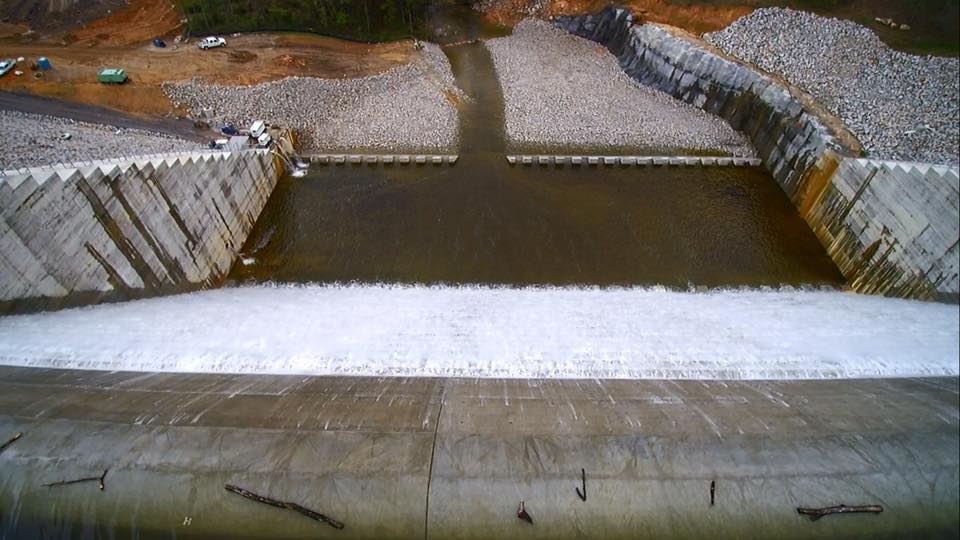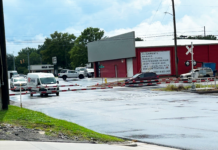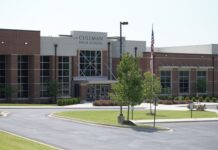With the reservoir at “full pool” in April 2016, water flowed down the spillway into the rectangular stilling basin at the bottom before rejoining the old riverbed. / Duck River Reservoir Project/Facebook
CULLMAN – Since the Utilities Board of the City of Cullman filed suit against the designers and builders of the Duck River Dam, quite a few readers have raised questions and offered commentary about just what the dam and reservoir are supposed to do.
From The Cullman Tribune Facebook page, (unedited for spelling/grammar):
“Water leaking into the dam? Is there open cavities inside the walls or something? I figured it would be solid concrete since this isnt a hydro electric dam.”
“Not getting a drop of water out of it, but we got walking trails!” Reply: “And paying for it.”
“Why haven’t they started the pipe project yet? Isn’t that suppose to be a given?”
“Guess I won’t be fishing there any time soon.”
“What’s the main purpose of this dam.” Reply 1: “Supply the city with a water source.” Reply 2: “Scenery to look at when we walk the trails.”
The Tribune looked for some answers.
Purpose of the dam and reservoir
According to a document from the Utilities Board of the City of Cullman related to the lawsuit, “The purpose of the Duck River Dam is to create an approximately 640-acre reservoir that will serve as a raw water source.”
Cullman Economic Development Agency Director Dale Greer offered more detail. “(The) purpose was to construct a dam to create a reservoir to impound water to serve as backup source and future supply for the area. Previous engineering studies had indicated Lake Catoma was not sufficient to continue to meet the water supply needs of the residential, commercial, industrial and agricultural needs of Cullman County. During the 2006 drought Lake Catoma was down 26 feet below full pool and the lake was not sufficient to meet our need for another 60 days. Even the most doubting individuals saw the forecast of a looming water shortage in Cullman County was accurate without a new supply source. The community growth in the past 10 years would imply our water needs will continue to grow.”
The Duck River Reservoir will supply raw water to a treatment plant, that will then supply drinking water to the city of Cullman. Cullman’s Water Department also supplies several other area water agencies.
While not cogent to the primary purpose, the Army Corps of Engineers allowed for certain recreational uses of the reservoir and its boundaries. The lake has been stocked with fish, and it was intended to be opened to fishing and other recreational activities after completion of the dam and one year after the filling of the reservoir. The land perimeter contains walking and bicycle trails.
Design of the dam and reservoir
The Utilities Board document describes the design: “The dam includes a center spillway section constructed primarily of roller compacted concrete, flanked on both sides by earth core/rock fill embankments. The concrete spillway section incorporates an internal concrete corridor, known as the ‘Gallery,’ that runs the length of the spillway (perpendicular to the riverbed) and into the west embankment.”
The gallery allows workers inside the dam to inspect and make repairs when needed to the internal structure. The gallery also houses electrical equipment. The dam is not designed to generate hydroelectric power, but it does contain powered equipment to control gates and valves that regulate water flow over the dam and downstream.
Rising water in the gallery following the Christmas flood of 2015 gave workers their first indication that something was wrong with the dam. It reached electrical controls, and shut down the valve and gate controls until they could be repaired.
According to the same Utilities Board document drawn from previously, the dam will also feature “an ‘Intake Tower’ in the reservoir to collect raw water for transmission to a pumping station and water treatment facility and a ‘Stilling Basin’ on the downstream side of the dam to dissipate the force of water flowing over the spillway before the water enters the downstream riverbed.”
The stilling basin will prevent water coming over the spillway (something that is intended to happen from time to time) from hitting the riverbed at the foot of the dam hard enough to erode the bed and possibly undermine the dam.
Pipeline project
The intake tower will draw water from the reservoir to be pumped out to a treatment plant for conversion to drinking water. The water will move via a pipeline system between the dam and plant.
In June 2016, the Cullman County Commission and City Utilities Board signed an agreement that would, according to Cullman County Engineer John Lang, “govern the perimeters surrounding the water line installation that will go from the new reservoir to the water treatment plant.” Lang also stated at that meeting that the agreement also provided that any portions of roads affected by the construction would be restored to “as good or better condition than what they found it after they get done completing the work.”
According to the project map, the pipeline will exit the lake near the intake tower in the reservoir just north of the dam, and cross County Road 1640 before turning south toward U.S. Highway 278. From there it will run along the north side of the highway, crossing to the south side just east of the County Road 747/278 intersection at Berlin. On the south side of the highway, the pipeline will turn due west. On the Cullman side of East Point, it will begin a series of turns north and west to take it into the Cullman Water Treatment Plant on Hwy. 278 near St. Bernard Abbey.
This pipeline was not a topic in the lawsuit, because the dam and pipeline comprised separate projects. Construction of the pipeline has not yet begun, but bids were taken the week before the suit was filed, and the impending legal action will not affect work on that project.
Greer explained, “The pipe work will go ahead. The bid was just over $9 million for the 7-mile pipe line back to the treatment plant. It will be constructed over 12 months (on property purchased as an easement so the landowner retains usage right). There was a lot said that the City of Cullman would use that pipeline to incorporate Berlin and other properties, but Alabama law prohibits easement use for that purpose.”
The delay in timing between the dam and pipeline was part of the Utilities Board’s plan. Since the reservoir was going to have to undergo a year of water quality monitoring before the board could begin pumping water to the treatment plant, and the million dollar-plus pumps had a one-year warranty, the board decided to delay the installation of pipes and pumps until the time for their use was closer.
Recreation on the lake/reservoir
According to a 2013 plan drawn up for the Utilities Board by St. John & Associates, the reservoir and its boundaries will be able to support the following recreational activities:
Boating
Fishing
Picnicking
Hiking
Sightseeing and photography
Nature observation
A walking/bicycling trail is already open around most of the reservoir’s perimeter. Due to concerns about pedestrian traffic crossing County Road 1669 in a blind curve, the City and County together recently constructed a pedestrian underpass below the County Road 1669 Duck River Bridge.
With many trails open, people are asking when the lake itself will open for fishing, boating and swimming. The projected date was as early as November of this year, but that will now depend on the settlement of the lawsuit.
During the press briefing on the lawsuit, Greer stated that the reservoir is required to undergo a year of water quality monitoring by ADEM (Alabama Department of Environmental Management). According to information provided by CEDA Project Coordinator Susan Eller, the one-year monitoring schedule is not arbitrary, but an amount of time required by federal environmental protection regulations. Under EPA regulations, the Duck River Basin is currently classified as a “fish and wildlife” waterway. Before water can be sent to the treatment plant, the basin must be reclassified as a drinking water source termed a “public water source.” A public water source can still support a fish population and can be used for certain recreational purposes, but meets quality standards needed to begin the treatment process for drinking water. Previous efforts by the Utilities Board have improved the water quality of the basin, and prepared it for reclassification, as soon as the required monitoring period concludes. Eller stated that the monitoring is around 25 percent complete at this point.
“When we finished the dam and plugged the dam in ‘15,” said Greer, “(the reservoir) was supposed to be filled by November of ‘16, and you would have had to have waited till November of ‘17 before you could use it. We’re running pretty close on that side, but I do not know about the repairs and the timing on it.”
Greer added, “Legal counsel advised against opening the lake to fishing and boating because construction continued (liability). Also, the lake water level was lowered 20 feet and the two public boat ramps were not useable. Most of the ramp work is now complete.
“We obviously built boat ramps, a fishing pier and had the Alabama Game and Fish Department stock bass and bream because we plan to open the lake to the public. The board will make the call in when to open the lake for public use. We opened parts of the bike trail that were away from construction and have allowed that use to continue.”
The lowering of the water level allowed access to the face of the dam for the repairs that are now the subject of litigation. The dam and intake tower are essentially complete, with the exception of the needed repairs. Until the lawsuit is settled and its terms are known, its effect on the timeline cannot be determined with any certainty.
So who’s going to pay?
With the cost of litigation and possible further work to be done to fix the problems at the dam, several Tribune readers have speculated that the cost is going to be passed on to Utilities Board customers.
Greer stated during the briefing that the suit should determine who is at fault and require them to take care of the problem at no cost to Cullman.
When asked by a reporter if there was a plan to pass along the cost, he responded, “No. That’s why we’re saying that we need to have them do that and fix it, and whatever the cost is, because the rate payers shouldn’t be responsible.”
Cullman Mayor Woody Jacobs, who was present for that part of the briefing, added, “Our whole thing has been to make sure that the customers, the rate payers, are protected.”
For more information on the Utilities Board lawsuit against CH2M Hill Engineers, ASI Constructors and ASI’s bonding agency Western Surety, see http://qrne.ws/dam.
For more information on water quality standards, visit the ADEM page at www.adem.alabama.gov/programs/water/wquality/2012WAM.pdf.
For more information on the Utilities Board Duck River recreation plan, view the plan drawn up by St. John & Associates at www.sjaonline.com/wp-content/uploads/2013/03/DUCK-RIVER-RESERVOIR-RECREATION-PLAN.pdf.
Copyright 2017 Humble Roots, LLC. All Rights Reserved.



























